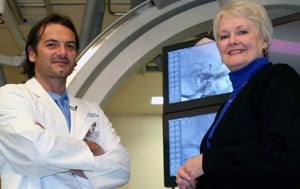Aneurysm Patient Finds Most Advanced Treatment at UAMS
| April 12, 2010 | Last year Lynda Etheridge was feeling fine and saw no need for a doctor-recommended brain scan to see if she had an aneurysm. Today she’s glad that her husband, Herb, convinced her to do it. The Etheridges, of North Little Rock, had seen Lynda’s brother undergo recent surgeries for three ruptured brain aneurysms and endure a long, difficult recovery. She was told by her brother’s doctor in Houston that aneurysms run in families and that she should be tested. Her husband urged her to follow through, and she got a nudge from her internist, so she agreed. In May 2009, she got the results of her CT scan. “They called me the next day and told me I had an aneurysm,” Lynda said. “I was shocked.” Lynda was referred to a Little Rock neurosurgeon. But instead of taking her case, he recommended that she see UAMS’ Dr. Eren Erdem, an interventional neuroradiologist who specializes in non-surgical catheter-based treatments of brain aneurysms. Meanwhile, Lynda was considering her options. “I thought I would have to go to Houston or the Mayo Clinic or someplace like that,” she said. “But the neurosurgeon told me Dr. Erdem is the best in the business.” About the same time she went for a mammogram, and her radiologist, who was familiar with Erdem’s work, told her, “Dr. Erdem is excellent.” Erdem is the only board-certified interventional neuroradiologist in Arkansas, and his skills have been recognized internationally. At UAMS, he directs the Division of Interventional Neuroradiology, where he provides a non-surgical alternative to repair both ruptured and unruptured aneurysms. He also is well known in his field for treating vascular malformations of the head and neck and using an innovative procedure known as kyphoplasty to help multiple myeloma and osteoporosis patients who are immobilized by painful vertebrae fractures. In fact, Erdem leads the world in the number of multiple myeloma patients treated with kyphoplasty. To treat aneurysms, Erdem uses a relatively new procedure known as coil embolization. During this procedure, a catheter is inserted in a major blood vessel in the inner thigh and maneuvered all the way to the brain. The coiled wire is threaded through a catheter sheath to the aneurysm. The coiled wire is added until it fills the aneurysm, and is left there, permanently. A clot forms around the coils like scar tissue, which blocks more blood from entering the aneurysm. More often than not, this is the preferred alternative to surgery for ruptured aneurysms, Erdem said. In a surgical procedure, a neurosurgeon has to manipulate brain matter to reach the aneurysm and clip it so that blood stops flowing into the aneurysm. Such invasive surgery has more risks than coil embolization, and the recovery period is significantly longer. Her aneurysm was not ruptured, but Erdem told her that it had a very high risk of rupturing within six months. She had the coiling procedure two weeks later and went home the following day. She said she was able to resume her normal, active routine within three weeks. “I feel great,” she said. “I’m doing everything I’ve ever done before.” |
